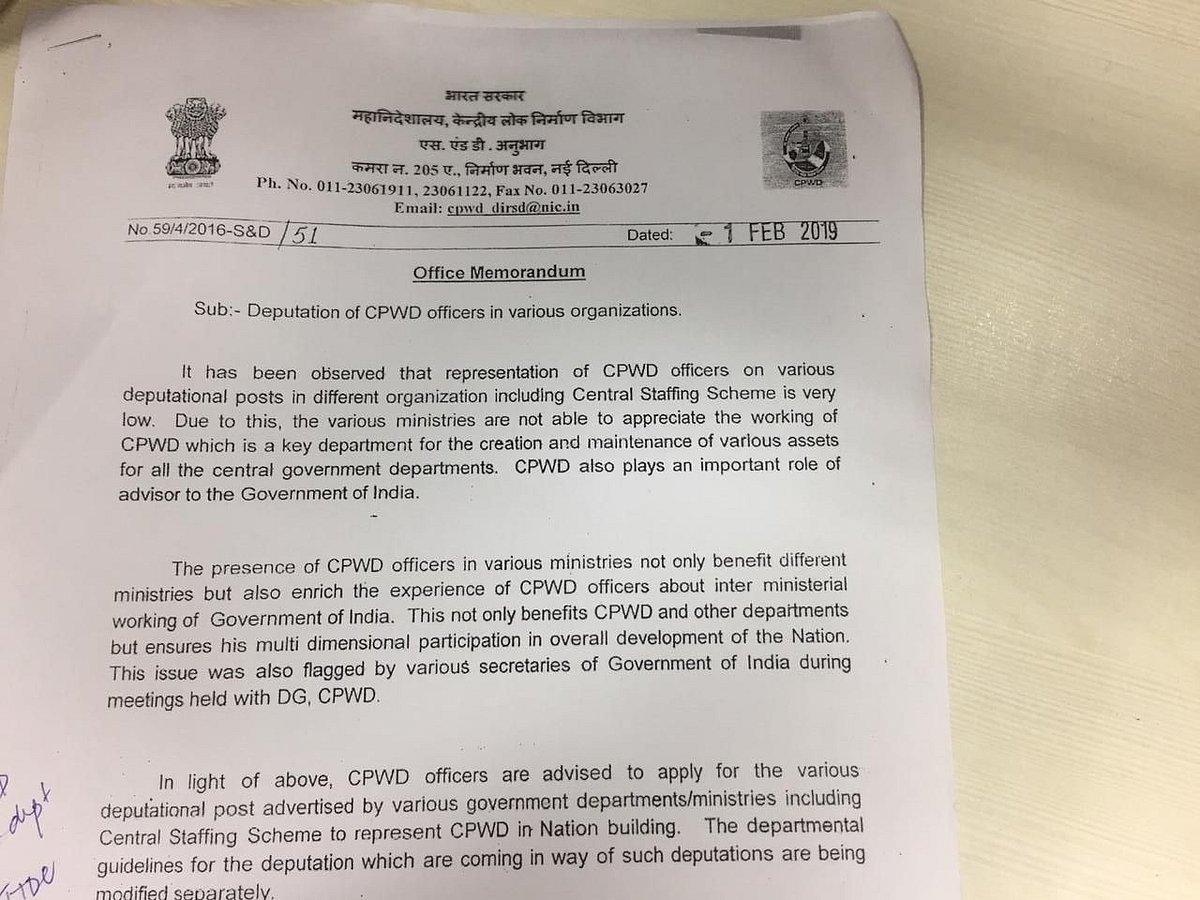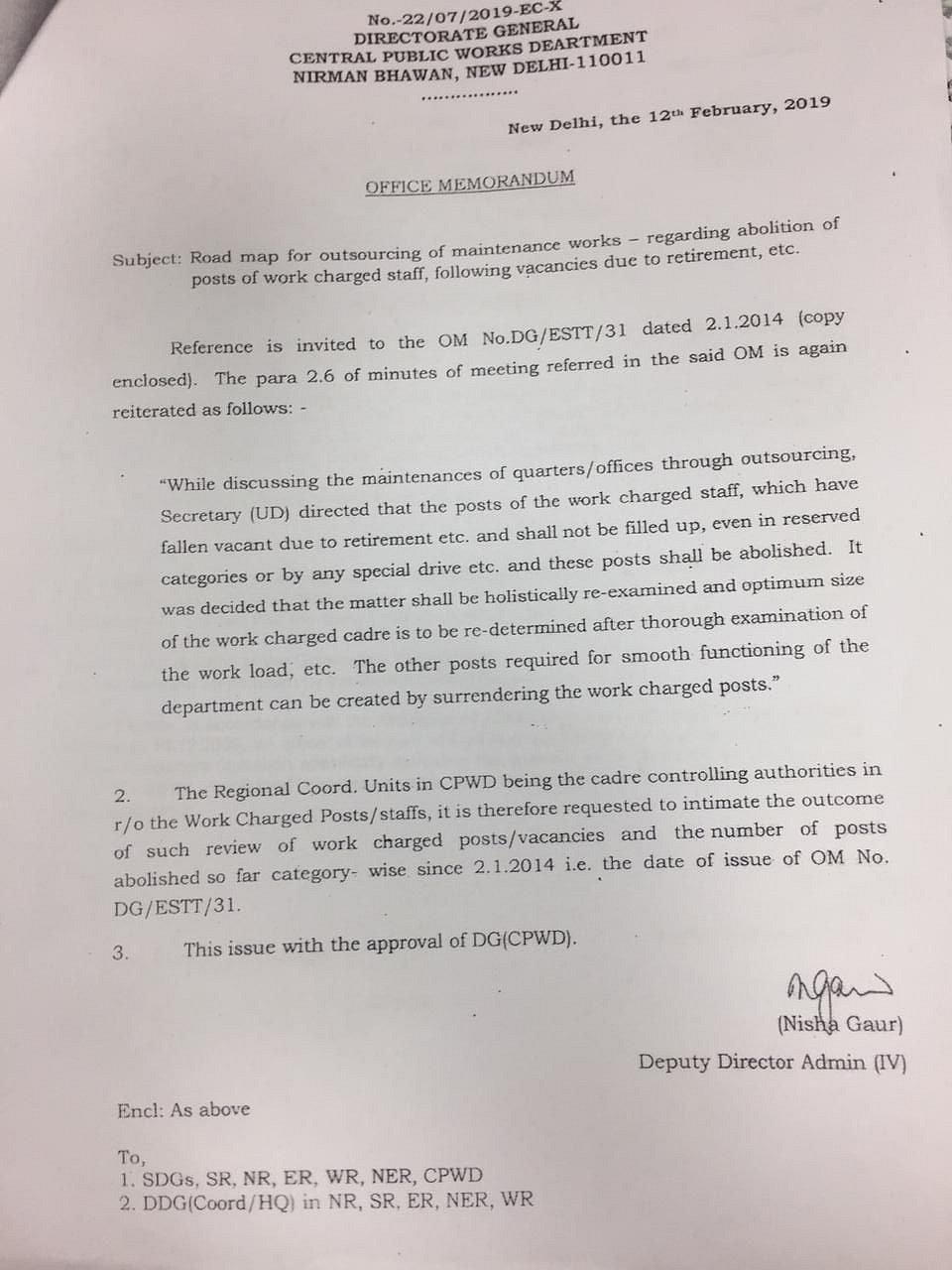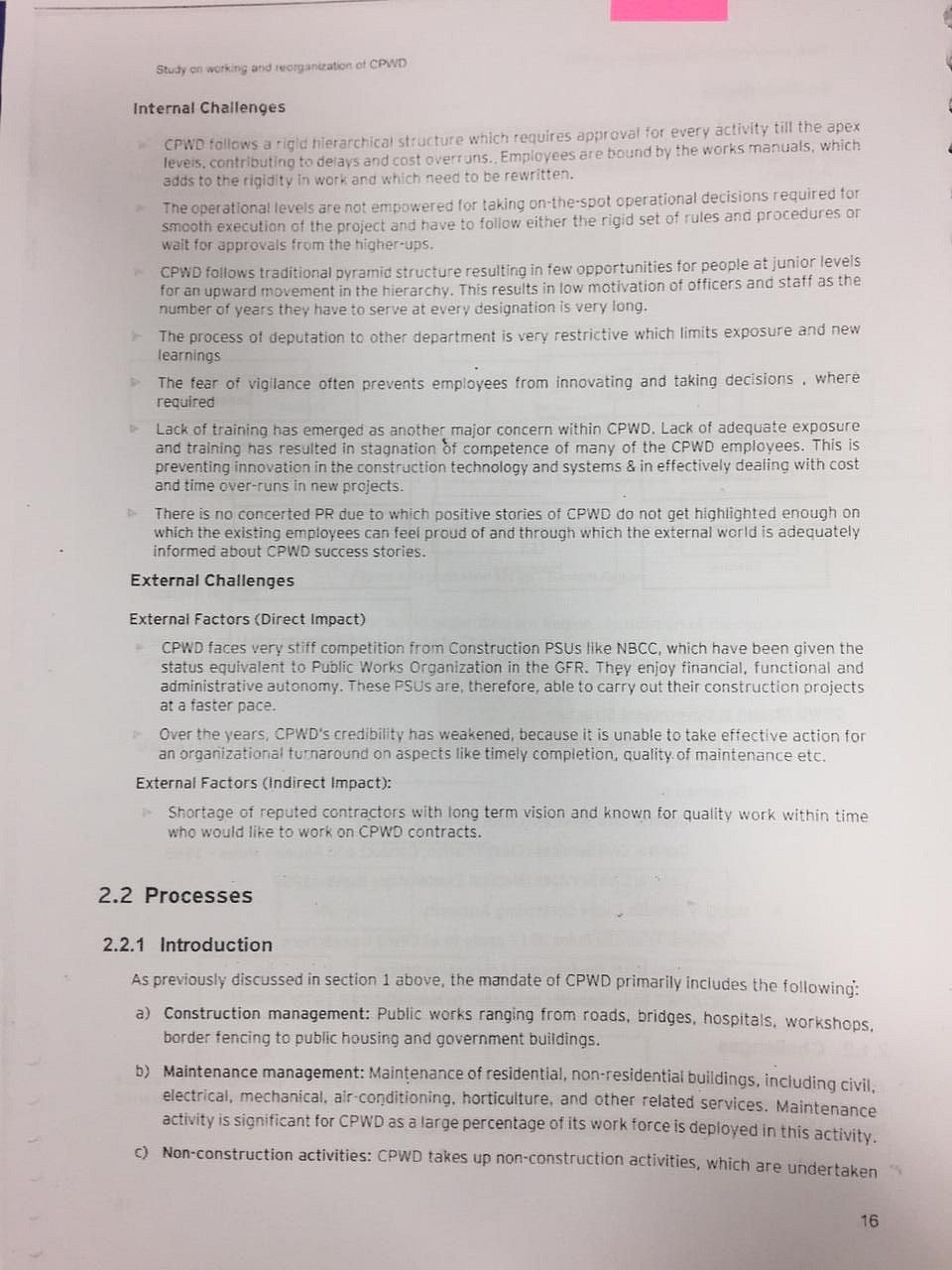Modi govt trying to dismantle 164-year-old CPWD, which built India
The Modi government has been working to slowly dismantle the CPWD by closing down various divisions, outsourcing many projects, abolishing various posts and banning hiring

One of the Modi government’s less understood slogans was ‘Minimum Government, Maximum Governance’. But almost five years later, it is slowly becoming clear what it meant. In a hat-tip to the slogan, the Modi government has been working to slowly dismantling several government institutions including the Central Public Works Department (CPWD).
For a few months now, the employees of CPWD have been protesting the shut-down of various divisions, ban on hiring and outsourcing of many projects, but most newspapers have ignored it.
Their first nationwide protest on December 12, 2018, was called off after the Minister of Housing and Urban Affairs Hardeep Singh Puri intervened. He had then promised to look into their issues. As was expected, nothing happened other than the office bearers of several unions being targeted. To protest this persecution, employees held a mass protest rally and a ‘March to the Parliament’ on February 12, 2019, which was a huge success.
What are the issues?
CPWD DG Prabhakar Singh has been planning to downsize CPWD with an aim of shutting down the department. As a first step to knock down the unity of the employees, he banned office bearers of the 15 CPWD unions from entering the Directorate.
After the union members had first called for a nationwide protest in December 2018, Singh issued notices to all associations stating that they had to submit more documents for the continuation of their recognition as unions. Singh then went on to declare only three of the 15 CPWD unions as legal and said that the others were unrecognised. Additionally, he transferred many of their office bearers to faraway stations. Almost all of them have gone to various tribunals and courts to fight it.
One of the derecognised unions AICPWDEA, which had got their recognition in 2001 as a union, went to the Delhi High Court. During the hearing the case, the CJI bench stated that “prima facie the DG of a department does not have authority to unrecognise a union” and stayed their removal from CPWD premises. The next date of hearing is March 18, 2019.
The CPWDEA, which has been a union for 64 years, approached the Central Administrative Tribunal and CAT stayed the DG’s order transferring the office bearers.
After engaging the office bearers in several cases, Singh closed down more than 15 divisions and circles including Pushpa Vihar division, Electrical Division 3 (ED), ED 5 and ED 10.
The department’s Material Testing Lab was also shut on January 3, 2019. This was where the materials such as cement, steel, water, tiles, bricks and concrete being used in construction and maintenance works in Delhi-NCR region were tested.
All CPWD, PWD units, DTTDC (Delhi Tourism and Transportation Development Corporation) and DSIDC (Delhi Tourism and Transportation Development Corporation) used to send materials here for testing. At this lab, the charges were nominal and would range from ₹300 - ₹1,500. Now, all of them will have to be sent to private testing labs, where the costs are higher, and the bills will run into crores. This help to the private industry has come at a cost to the exchequer.
On February 1, 2019, an office memo was sent out stating that CPWD officers hardly go on deputation and because of this “various ministries are not able to appreciate the working of the CPWD which is a key department for the creation and maintenance of various assets for all central government departments”. It said such deputation “not only benefits CPWD and other departments, but also ensures his multi-dimensional participation in the development of the nation”.
There are, of course, guidelines which govern such deputation, but in the same letter, the ministry made it clear that “the departmental guidelines which come in the way of such deputations were being modified”.
This memo was followed up with another one on February 12, 2019, which was a road-map for the shutting down of the department. It mentioned outsourcing of maintenance works, ban of hiring for posts such as plumbers, carpenters, masons, electricians, wire men (Group C employees) even in SC/ST categories and eventually abolishing these posts. The other posts required for the smooth functioning of the department can be created by surrendering these posts, said the note.
A number of comprehensive maintenance works of existing government colonies which are usually done by CPWD have been outsourced to private contractors at abnormally high rates. This has happened with all colonies in RK Puram Sector 1- 13, PushpVihar, Gole Market, Aram Bagh, Timarpur, Kaka Nagar and Pandara Road. The department used to maintain 65,000 quarters in Delhi alone and now none, rendering a number of the staffers jobless.
Several of the projects which should have gone to CPWD have been awarded to NBCC (National Buildings Construction Corporation), where Durga Shanker Mishra, who is currently the secretary of the Urban Development ministry, was the nominee director in 2017. And this too has bled the exchequer.
According to the rules, no central government ministry can award a contract to any PSU on nomination basis. Despite this rule, the MoUD awarded to NBCC several projects without any competitive bidding amongst even the PSUs. Moreover, NBCC charges around 8% to 10% as a fee for executing projects, while CPWD charges nothing as it is a government department created to do such works. Awarding such projects to PSUs have led to a cost escalation.
Nine large mega-sized projects in Delhi, including development of New Moti Bagh, Kidwai Nagar, Naoroji Nagar and Netaji Nagar, estimated at the cost of ₹ 60,000 crore were given to NBCC. This gives rise to suspicion that a scam involving the NBCC and MoUD is underway.
In a response to TRS MP Prabhakar Reddy Kotha’s question on the ‘Outsourcing of tenders’, the minister Hardeep Singh Puri had stated that it was not mandatory to abide by the prequalification criteria listed in the CPWD Works Manual 2014.
When did the issue begin?
In January 2017, a committee of secretaries headed by Rajiv Gauba (he is currently the home secretary of India) had mooted a proposal to convert the 164-year-old government department into a PSU on the lines of the loss-making corporation BSNL or NBCC. Along with Gauba in this department, there was Durga Shanker Mishra, who was then the additional secretary – Urban Development Ministry. In 2017, Mishra was also the nominee director of NBCC, despite there being direct conflict of interest.
When the employees found out about this move, there was a groundswell of opposition across the country and a protest rally was called for February 22, 2017. The government kept silent. When another protest was planned on March 22, 2017, the then Urban Affairs Minister Venkaiah Naidu called the protestors to his residence to discuss the issues.
At the meeting Naidu insisted that there was no agenda to privatise CPWD. He said that there were inexplicable delays in the projects handled by CPWD and that the department was riddled with corruption. Naidu then added that the Modi-led government had no tolerance towards corruption.
Soon after the meeting, the ministry appointed Ernst & Young at a cost of Rs 50 lakh to study the CPWD and suggest ways to reorganise the department. In the report, which is in possession of National Herald, it has been stated that the department was top heavy and needed to be restructured without downsizing to better efficiency.
In the CPWD, there are four departments – Architecture, Civil, Electrical and Horticulture. In the civil department, the hierarchy from bottom-up is as follows: First the junior engineer (JE), assistant engineer (AE), executive engineer (EE), superintending engineer (SE), chief engineer (CE), assistant-director general (ADG), special director general (SDG) and then the director general (DG). The executive engineer is the highest nodal officer for the execution of work. From the superintending engineer onwards, it’s an administrative post.
The report suggested the delayering of EE and SE and that both would report to CE; and ADG and SDG would report to DG. This was mainly to reduce many layers in decision-making process, to improve efficiency and ensure more officers in execution roles than in administrative roles.
Going against the E&Y report, which the government has refused to make public, the government created one more post DG(Planning)and also amended the DoPT guidelines. The government modified the hiring guidelines in June 2018 to promote SDG (Elect) Prabhakar Singh as the DG. He was set to retire on July 31, 2018, exactly a month after his promotion, but the government again violated the DoPT norms and statutory rules such as the FR-56 and re-employed him for one more year even though there were several other eligible officers who could be promoted as the DG. To placate SDG (Arch) RK Thathu, who is senior to Singh, and was in line to be promoted as the DG, the government appointed him as the DG(Planning).
FR-56 is the retirement procedure of the government and Department of Personnel and raining (DoPT) is the Central Government’s coordinating agency for recruitment.
Why the re-employment of Prabhakar Singh raises eyebrows?
Singh has several corruption cases pending against him with the PMO and Central Vigilance Commission. He had approved more that 300 work orders during his four-year tenure as CE(New Delhi Zone-I) at very high rates with limited tenders and caused a huge loss to the exchequer.
Instead of following procedures, he had promoted several junior EEs as SEs by superseding many senior EEs. Earlier, there used to be a committee headed by the SDG for recommending transfers and posting of executive engineers. He dissolved the committee and appointed himself as the chairperson of the transfers committee in November 2018.
Additionally, he had also concealed immovable property in his name at Balia and had instead stated from 2010 to 2018 that he had no property.
A case against his appointment is pending at the Delhi High Court and the next hearing is on March 19, 2019.
What has also gone under the radar is that Singh’s son Rahul Singh, who was an IRS officer, quit and began his own business venture in partnership with Durga Shanker Mishra’s son Atal Mishra. It has not been ascertained yet if they have got any contracts.
Calls to both Prabhakar Singh and Durga Shanker Mishra went unanswered. If and when they respond, this article will be updated.
What is the state of affairs now?
There is gross under-utilisation of this government department and several of the employees have been suspended. Several of the posts remain vacant and there are no plans to hire even in this environment where joblessness prevails.
What is the CPWD?
While all of us are aware about its existence, this government department which has around 40,000 employees, is the one which is involved in the development of public infrastructure like roads, bridges and buildings and maintenance of these buildings and government colonies. It was constructed the Parliament building, the President’s home, buildings of several ministries and several border outposts.
The maintenance at the CGO Complex, where a fire broke out two weeks ago, used to be handled by the CPWD until was given to a private agency a couple of years ago.
Follow us on: Facebook, Twitter, Google News, Instagram
Join our official telegram channel (@nationalherald) and stay updated with the latest headlines
- Delhi High Court
- CPWD engineers
- Hardeep Singh Puri
- Central Administrative Tribunal
- Minimum Government, Maximum Governance
- Central Public Works Department
- AICPWDEA
- DSIDC
- NBCC
- Durga Shanker Mishra
- Prabhakar Singh




